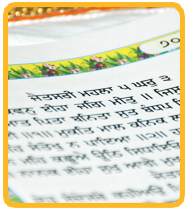The numerical expression has a significant bearing on Ghar in Gurbani largely because Ghar itself is named as Pehla (First), Dooja (Second), Teeja (Third) etc.
Therefore, when initial attempts were made to explore the concept of Ghar, the seekers naturally tried to find solution of Ghar out of Taal (Rhythm). This was precisely because of the prominent usage of numerical in Gurbani Music in the form of Taal. The beats of Taal are measured in numerical. At times, even the names of a few Taals are in numerical [like Ek (meaning one) Taal, Teen (meaning three) Taal].
However, there is hardly any ambiguity on the issue of any association of Ghar with Taal in Sri Guru Granth Sahib. Guru Sahib seals the issue by attributing Ghar to Partaal. By doing so, Guru Sahib declares, loud and clear, that Ghar is not based on Taal. It is an established fact that, singing a sabad in Partaal means singing a sabad in two or more taals. When Sri Guru Granth Sahib associates Ghar to Partaal, then any assumption of association of Ghar with Taal is rendered infructuous.
When Ghar could not be correlated with Taal, the Ghar was assumed to be associated with sur (swar in Hindi) or a musical note. There is an ancient reference of ‘Greh Swar’. The two other related references are ‘Ansh Swar’ and ’Nyass Swar’. The Greh sur is the musical note from where raag begins and Nyass is the sur where the raag ends. Due to naturally prevalent variability in the starting sur in various compositions of the same raag, the Greh sur is seldom referred to, now. Similarly, Nyass sur has met the same fate, and for the same reason. Whereas Greh swar and Nyass Swar, being less realistic, have largely been abandoned, the Ansh Swar i.e. the most used sur of the raag that remains constant for a raag irrespective of the variation in composition, has a practical usage and, therefore, is still is use though it is now popularly called as Vaadi sur. Oblivious of these fundamental facts, few scholars correlated Greh sur with Ghar of Gurbani apparently owing merely to the translational correlation between the two words i.e. Greh in Hindi and Ghar in Punjabi. However, this correlation fails to stand the test of Ghar vis-à-vis directives about Ghar enshrined in Sri Guru Granth Sahib.
When Ghar could not be associated with sur, attempts were made to associate Ghar with Raag. Although Raag, in contrast to Taal, has no numerical significance, yet it was dragged into association with Ghar owing to close proximity of raag with Taal. However, with same raag being in different types of Ghar and same type of Ghar being in different raags, therefore, any specific association of a raag with a particular type of Ghar is not feasible.
When raags could also not be associated with Ghar, a last ditch effort was incurred to associate Ghar with the feel of Raag! This was owing to certain specific feels correlated with certain raags, which might have tinkled the possibility of exploring any relationship of feel of the raag with Ghar of Raag. But this assumption was also not tenable beyond a few raags that represented happiness, sadness, war or season, even within such raags, there were different types of Ghar that defied any association of any feel with a particular Ghar.
However, like in case of Taal, no relationship of sur, raag or its feel has been authenticated by test of Ghar-related directives in Sri Guru Granth Sahib to consider any of the above supposition to be associated with Ghar of Sri Guru Granth Sahib. Further, none of these suppositions have offered any explanation for relating with eight types of Chhant Ghar.
The present accomplishment of concept of Ghar has finally provided the right perspective to the numerical association of Ghar.
The present book is the result of close observation of every heading of Ghar in Sri Guru Granth Sahib. It has been found that, by indicating numerical association of Ghar, Guru Sahib has instructed the methodology to read and sing Gurbani.








